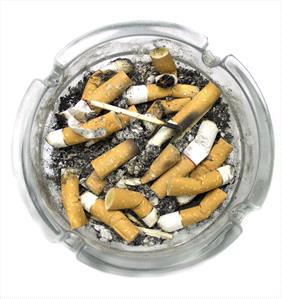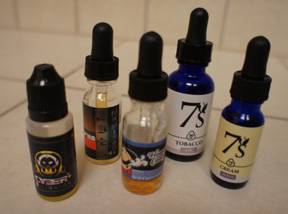Ashtray

Definitely not pet treats. Photo courtesy of Depositphotos
Everyone knows the Surgeon General’s warning about cigarette smoking but what about cigarette eating?
Nicotine poisoning is a real concern anywhere that a pet may find cigarettes, cigarette butts, chewing tobacco, nicotine gum, patches, or e-cigarettes. Dogs, particularly puppies, tend to chew things up first and ask questions later. Cats may find a cigarette butt to be a nicely sized pouncing toy worthy of chewing.
Luckily for pets and small children, tobacco tastes terrible. Even chewing tobacco must have flavorings added to make it worthy of oral enjoyment. Still, cigarettes have plenty of nicotine and even a small cigarette butt can mean serious illness or even death for a small pet.
The toxic dose for nicotine in pets is 0.5 to one mg per pound of pet body weight while the lethal dose is four mg per pound of pet body weight. So how does this translate to nicotine-containing products? A cigarette contains between 9 & 30 mg of nicotine depending on the type of cigarette. When the cigarette is smoked, the nicotine concentrates down in the oral end meaning that a small nub of a cigarette butt will retain 25% of the nicotine contained in the original cigarette. Smoking a cigarette yields 0.5-2.0 mg of nicotine to the smoker but eating the cigarette (or other nicotine product) is a whole different ballgame as all of the nicotine becomes available for absorption into the body. Consider that a 2-lb dog would only need 10 mg of nicotine to become poisoned and a 40-lb dog would need only 1cc (less than a quarter teaspoon) of e-juice.
- Cigarettes: 9-30 mg of nicotine
- Cigarette butts: 2-8 mg of nicotine
- Cigars: up to 40 mg of nicotine
- Chewing tobacco: 6-8 mg of nicotine per gram
- Nicotine gum: 2-4 mg of nicotine per piece
- Nicotine patches: 8.3-114 mg of nicotine
- E-cigarette cartridges: 6-36 mg of nicotine
- E-juice/E-fluid (to refill E-cigarettes): up to 36 mg of nicotine per ml

Electronic cigarette juice. Photo by VIN.
Some good news is that nicotine is not absorbed directly in the acid environment of the stomach; the nicotine must move past the stomach into the small intestine for absorption. One of the first things nicotine does in the body is to stimulate the vomiting center of the brain, thus inducing vomiting that may save the patient’s life if there is more cigarette material in the stomach.
Symptoms of Nicotine Poisoning
Signs begin as quickly as one hour post-ingestion. Symptoms include:
- Tremors
- Constricted pupils
- Drooling
- Auditory and visual hallucinations
- Excitement
- Vomiting and diarrhea
- Twitching, possibly progressing to seizures
- Racing heart rate but slow heart rate with small doses
- High blood pressure but at higher doses, there is a circulatory collapse
It is easy to confuse nicotine poisoning with other poisonings such as strychnine, chocolate, organophosphate insecticides, and certain molds. Hopefully, there will be cigarette materials in the vomit to give away the diagnosis. It is also worth mentioning that some nicotine gums contain xylitol as a sweetener. This material is toxic to dogs and can add an entirely new dimension to nicotine poisoning.
Treatment
If not too much time (an hour or so) has passed since consumption of the nicotine product, vomiting can be induced. Washing out the stomach to get rid of any remaining cigarette materials is helpful but is likely to require sedation as well as activated charcoal to bind the nicotine and prevent it from entering the body. Obviously, this would be performed at the veterinarian's office.
Treatment is basically supportive after that. Intravenous fluids support circulation while the body gets rid of the nicotine. If seizures or tremors are occurring, medications will be needed to suppress them. If the pet survives the first four hours, the prognosis is felt to be good. Nicotine is inactivated by a healthy liver and its metabolites are excreted in the urine. After 16 hours, the nicotine ingested should be gone.
The National Animal Poison Control is available 24 hours a day at 888-426-4435 and consultations cost approximately $95.00. Once a case number has been assigned, follow-up is free, which means you can get initial first aid information before seeing your veterinarian and your veterinarian can consult with a toxicology specialist before beginning treatment.